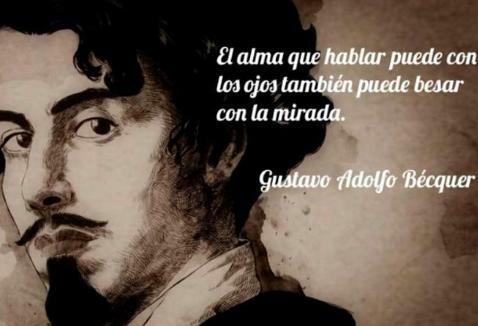19th century Spanish literature: SUMMARY and characteristics

Image: Aweita.pe
Do you want to know better what happened to Spanish literature during the 19th century? After the Enlightenment period where France became a benchmark for culture and reason, the world of letters and culture took a great turn, inaugurating this period with a heyday for fantasy and delusion. The romantics inaugurated this century with a large dose of sentimentality, passion and imagination, thus shelving the previous movement of Neoclassicism. In this lesson from a TEACHER we are going to show you a summary of 19th century Spanish literature as well as the characteristics and the most prominent authors of this period. In this way, you will get to know better the cultural and literary history of the country and understand everything that happened.
Index
- Introduction and summary of 19th century Spanish literature
- Main characteristics of 19th century Spanish literature
- Most outstanding authors and works of Spanish literature in the 19th century
Introduction and summary of 19th century Spanish literature.
We begin this brief summary of 19th century Spanish literature by talking about the two periods into which this moment in history is usually divided. During the first half we witness a moment where liberalism triumphedIn other words, the bourgeoisie began to come to power and the first liberal revolutions took place. In the second half of the 19th century, we witnessed the consolidation of liberalism both on a political, social and economic level. Capitalism has triumphed and now a new stage in the history of society begins.
All this political-social context is reflected in the literature and in the works that were cultivated during the XIX century. The first half of the century is the moment of Romanticism, a current that has that most revolutionary spirit and with the will to change; the second half is that of Realism, a calmer and more pragmatic movement that wants to lower that attitude of idealism and revolution in order to understand reality as it is.
First half of the XIX: Romanticism
The movement of the Romanticismit is a movement that has always been linked to liberalism. The attitude of the romantic faithfully expresses what was lived at the social level throughout Europe: revolutions to implement another possible world, an exaltation of life and the power of the enormous individual, etc. And this is what we see in this current that has very specific characteristics such as the exaltation of feelings, the search for freedom and individuality.
This literary movement was inaugurated in Germany with the movement "Sturm und Drang" where we find prominent authors such as Schiller or Goethe.
Second half of the XIX: Realism and Naturalism
On the other hand, during the second half of the 19th century we witnessed an important change of perspective. The Realismit is the consolidation of everything that has been demanded in the first half but with a more measured vision and with less influence from emotions and feelings.
One of the motivations for this change was the mobilizations carried out by the workers and that they became very strong towards the middle of the century. The bourgeoisie abandoned the social movement to make way for citizen and worker mobilization that wanted to defend their place in the world and their rights. Realism will want to reflect the inequalities that exist in society and put aside romantic idealism in order to see what the true situation of the people is.
Some of the most outstanding characteristics of Realism are that they imitate the scientific method when analyzing and writing about reality, who use objective language to be able to describe rationally and without the influence of their opinions or feelings.
The Naturalismwas another stream that appeared to late XIX and that it is an evolution of Realism but it is NOT the same. It is a movement that appeared from the hand of Emile Zola and that took a step further to link literature with the science: he considered that the novelist should have a completely scientific look to be able to approach reality and experience with her.

Image: Slideshare
Main characteristics of 19th century Spanish literature.
We are now going to talk about the characteristics of 19th century Spanish literature to better understand all the cultural movements that took place in this century. As we have already said, we find 3 different trends that are located at different moments of creation artistic and, therefore, to know the characteristics of each period, we will divide this section into the different currents.
Romanticism and its main characteristics
Romanticism was a movement where the "creative self" was placed at the center of literary creation. The poet's universe became the topic to talk about and, therefore, there is a great abundance of feelings, emotions, thoughts, imagination, etc.
Here we leave you some characteristics of Romanticism that you have to know:
- Individualism: art will be used to speak in a subjective way about the particular world of each creator. External reality is left aside so that the poet's own universe is the basic topic to talk about.
- Subjectivism: the poet, when talking about his own personal world, applies a subjective discourse where he always speaks from his point of view and from his perspective
- Fantasy and imagination: the study of the mind and the subconscious is something typical of the romantics who want to know better how the imagination works. Fantasy and supernatural events will be very present in this current of 19th century Spanish literature
- Defense of freedom: Creative freedom of thought and feeling is what the romantics who are influenced by the social current in Europe are looking for.
- Idealism: Romantics are idealistic creators who pursue an ideal world, an ideal love, and an ideal life. As this cannot be achieved, that's where that desperate and sad attitude so typical of romantic works comes from.
- Preference for poetry: is the favorite literary genre of romantics for offering the tools they need to express their emotions and passionate outlook on life.
- Nationalism: the defense of freedom and romantic individuality had an influence on societies, resulting in the rise of nationalist sentiment in the regions
Characteristics of Realism
In the second half of the 19th century, the tables were turned and the sentiment and exaltation typical of Romanticism was replaced by a more earthly and moderate vision: that of Realism. Some own characteristics of this movement are the following:
- Objectivity: the poet does not want to talk about his vision of life (subjective) but to talk about life in a general way and without the influence of his feelings or opinions. Objectivity is the new vision of authors who will want to describe life as it is.
- Omniscient narrator: During Romanticism, authors used the first-person narrator because they were talking about themselves but, now, the The narrator ceases to be part of the story so that he can describe everything he sees in an objective and distanced.
- No fancy: the realists fled from fantasy and exoticism to reflect real stories that take place in real places. For this reason, they focus on explaining stories that happen every day in cities and with which everyone can feel identified.
- Use of the novel: the realists stopped cultivating the genre of poetry to bet on the novel, a genre in which they can expand with their descriptions and use a more restrained and natural language.
Naturalism and its main characteristics
Emile zolaHe is the writer who inaugurated Naturalism, a literary trend that draws on the influence of Realism and that considers the writer as a scientist who can experiment with reality. The novel becomes his personal laboratory to get to know society and better understand human behavior. In Spain, Emilia Pardo Bazán was the most influenced and prominent author of this movement.
Some of the most prominent features of the movement are as follows:
- Social determinism: the human being is conditioned (determined) by different social factors such as, for example, genetics, social class, our gender, etc.
- Objectivity: as in Realism, in this current we want to know reality well and, therefore, avoid the influences of the authors and bet on a discourse away from feelings
- Scientific method: naturalists use the scientific method to develop their work well. They observe, annotate, and write objectively to convey their knowledge.

Image: Comparison Chart
The most outstanding authors and works of Spanish literature in the 19th century.
And we finish this summary of 19th century Spanish literature to talk about the most outstanding authors and works of this historical moment. The truth is that there are a large number of important names but, so that the list is not excessively long, here we will indicate some of the most prominent in Spain.
Most important authors of Romanticism
- Mariano José de Larra and his "Articles"
- The poetry of José de Espronceda
- José de Zorrilla and "Don Juan Tenorio"
- Gustavo Adolfo Bécquer and his "Rhymes and Legends".
Spanish authors of Realism
- Rosalía de Castro: "On the banks of the Sar".
- Leopoldo Alas, Clarín: "The Regenta"
- Benito Pérez Galdós: "Fortunata and Jacinta" and "National Episodes"
Authors of Spanish Naturalism
- Emilia Pardo Bazán: "The pazos de Ulloa".
- Vicente Blasco Ibáñez: "La barraca".

Image: Europa Press
If you want to read more articles similar to 19th century Spanish literature: summary and characteristics, we recommend that you enter our category of History of Literature.



